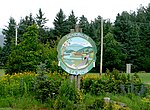The Ottawa Valley is the valley of the Ottawa River, along the boundary between Eastern Ontario and the Outaouais, Quebec, Canada. The valley is the transition between the Saint Lawrence Lowlands and the Canadian Shield. Because of the surrounding shield, the valley is narrow at its western end and then becomes increasingly wide (mainly on the Ontario side of the river) as it progresses eastward. The underlying geophysical structure is the Ottawa-Bonnechere Graben. Approximately 1.3 million people reside in the valley (and along its tributaries), around 80% of whom reside in Ottawa. The total area of the Ottawa Valley is 2.4 million ha (6 million ac). The National Capital Region area has just over 1.4 million inhabitants in both provinces.
Near the City of Ottawa, the Ottawa Valley merges with the St. Lawrence Valley to the south to create a delta of flat farmland stretching unbroken from the Ottawa River to the Saint Lawrence River as far east as the island of Montreal, where the two rivers meet. The area is sometimes referred to as the "Lower Ottawa Valley," in contrast with the "Upper Ottawa Valley" west of Ottawa, but the name is not common, and most people think of the Ottawa Valley as only the upper portion.
From west to east, communities in the Ottawa Valley include Mattawa, Deep River (with nearby Chalk River, the site of Canada's nuclear reactor program), Petawawa (a major Canadian military base), Pembroke (where Samuel de Champlain landed briefly), Fort Coulonge, Shawville, Renfrew, Quyon, Arnprior, Ottawa (the nation's capital), Rockland, L'Orignal, Hawkesbury, and Rigaud and Almonte, Round Lake Centre, Dacre, Douglas, Hyndford, Scotch Bush, Osceola and Barr Line.







